Provenance
- Painted between 1556 and 1559 for Philip II, King of Spain; by descent to Philip V
- By whom presented to Antoine, 4th Duc de Gramont, French Ambassador to the Spanish court, 1704
- By whom presented, probably around 1706–8, to Philippe, 2nd Duc d’Orléans, later French regent
- By descent at the Palais-Royal, Paris, to Louis-Philippe-Joseph, Duc d’Orléans (Philippe Egalité), by whom sold in 1792 to Édouard Walckiers of Brussels (but resident in Paris)
- By whom sold in the same year to his cousin François-Louis-Joseph de Laborde-Méréville, Paris
- By whom transported to London in 1793 and mortgaged to Jeremiah Harman
- By whom sold in 1798 to the dealer Michael Bryan, acting on behalf of a syndicate consisting of Francis Egerton, 3rd Duke of Bridgewater, his nephew George Granville Leveson-Gower, Earl Gower (later 2nd Marquess of Stafford and 1st Duke of Sutherland) and Frederick, 5th Earl of Carlisle (husband of Lord Gower’s sister)
- Reserved by the Duke of Bridgewater
- By whom bequeathed in 1803 to Lord Gower
- By whom bequeathed in 1833 to his second son Lord Francis Leveson-Gower (who took the name Egerton in 1833 and was created 1st Earl of Ellesmere in 1846)
- By descent to John Sutherland, 5th Earl of Ellesmere, from 1963 6th Duke of Sutherland, by whom placed on loan to the National Gallery of Scotland in 1945
- By whom bequeathed to Francis Egerton, 7th Duke of Sutherland in 2000.

